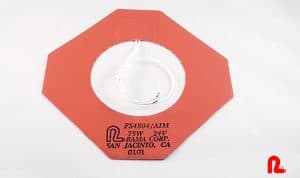Silicone Rubber Heater with 3D Forming For Aerospace Application
Components built for use in aerospace applications, like water pipes and valves, often encounter various novel challenges. One of the most significant difficulties is working at a high altitude of approximately -50 degrees Fahrenheit temperatures. It is nearly always required to heat these components using considerable heating elements (such as silicone rubber heaters) to prevent icing and guarantee that pumps run smoothly and without interruptions in flow. Any ice accumulation inside the pipes may have disastrous consequences at such a high altitude and cold temperature.
The Ultimate Solution: 3D-Formed Silicone Rubber Heater

At Rama Corporation, we frequently come into contact with various customers who supply components and accessories to the aerospace industry and are also searching for heating solutions for water valves and pipes. These valves or pipes could have a small and delicate geometry, and they might be situated in an area of the aircraft that is neither pressurized nor heated. It is also conceivable that the piping before and after the component is heated.
Still, the part must also be heated for the process to be successful. For example, this would guarantee that no ice occurred when the liquid flowed through the valve’s body. The creation of a 3D-formed silicone rubber heater is the only way that is capable of applying heat efficiently.
Essential Characteristics of Silicone Rubber Heater
Hence, the ultimate answer is a heater made of silicone rubber that has been molded into a cube shape. It is intended for the heater to draw power from a control box located in the aircraft’s undercarriage and run at an appropriate pressure to prevent freezing. Along these lines, some of the significant characteristics of the silicone rubber heater include the following:
- The use of fiberglass-reinforced silicone rubber in constructing efficient, water-resistant, long-lasting, and flexible heaters gives these items additional advantages.
- It is possible for the fittings on the valve to pass through the heater thanks to the holes that are present on three of the faces of the heater.
- The heater is covered with thermal insulation to shield the rear side from excessive heat. Most of the heat may be directed towards the valve body.
- A snap-action thermostat with heater sense and open/close setpoints has been added to the heater’s body. It provides more accurate control and prevents the valve from overheating.
- The thermostat’s setpoints (such as 70 degrees Fahrenheit and 40 degrees Fahrenheit) maintain a heater’s working temperature higher than the point at which water freezes. Eventually, it helps avoid any ice formation inside the valve body.
- The vast majority of silicone rubber heaters are also relatively thin, allowing them to squeeze into congested areas and conform to a wide range of diverse shapes and sizes.
- Because of the thermostat’s one-of-a-kind dimensions, a specialized mold must be created, and the sponge must have cuts to fit into the mold properly.
We Are Excited To Be Of Service To You!
We at Rama Corporation are excited to be able to provide you with bespoke heating elements of the highest possible quality, including silicone rubber heating elements. Reap the benefits of our more than seven decades of expertise in creating customized heating elements. For further information, please fill out the quotation form on the page here.
